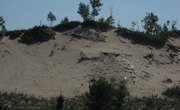
Much of the Midwestern state of Missouri is covered with forests, including Mark Twain National Forest in the southern region of the state. Other Missouri habitats include the submerged wetlands, underground caverns and highly populated cities, including St. Louis, Kansas City and Columbia.
Forests
As of fall 2010, Missouri has more than 14 million acres of forests and is ranked seventh among the U.S. states in term of forest acreage. Much of the Show Me State's forests are privately owned, 85 percent, but the public has access to state and national parks. The largest forest ecosystem in Missouri is the 1.5-million-acre Mark Twain National Forest. This forest is on the northern hills of the Ozark Mountains and spreads over 29 counties. Common trees in Missouri forests include the scarlet oak and Missouri hickory.
Wetlands
Wetlands are areas where land surface is covered by water, such as swamps, bogs and marshes. When Missouri was first settled in the 19th century, the state had more than 2.4 million acres of wetlands. As of 2010, there are 60,000 acres remaining — 2 percent of the state. The loss of wetlands is attributed to highway construction and drainage for farming development. Missouri's wetlands are habitats for a variety of wildlife species, including the green tree frog, beaver and waterfowl birds.
Caves
Missouri is home to more than 6,000 caves, making it the state with the second-largest number of caves in the United States. Caves are formed when water sinks through limestone and bedrock layers of the Earth's crust and erodes the land underneath these layers. Karst is the name of the topography that includes caves and sink holes. Missouri's caves are home to more than 900 land and marine animal species, such as Ozark cave fish, cave salamander, dwarf American toad and eastern Phoebe, a bird species. Guided tours are available to the public in certain caves, including Onandaga Cave and the Onyx Mountain Caverns.
Urban
An urban ecosystem includes human-developed cities and how those areas impact its surrounding environment. Missouri's urban ecosystem consists of approximately 6 million people living in more than 960 cities and towns. The two largest urban ecosystems in Missouri are Kansas City and St. Louis. Environmentally sound urban ecosystems have efficient smog control, road infrastructures and water-supply systems. An example of environmentally sound urban feature is St. Louis' Metro Transit system, which is a smog-free form of transportation. Urban ecosystems also have government-protected and maintained city parks, which offers natural environments with trees, wildlife species and lakes. Large urban parks in Missouri include Forest Park in St. Louis and Riverfront Park in Kansas City.
References
Resources
About the Author
Skip Davis has been writing professionally since 2005. His work has appeared in "Southern Literary Magazine," on various websites and in graphic panels at the Jackson Zoological Park in Jackson, Miss. Currently living in Southern California, Davis received his Bachelor of Arts in theater at Belhaven College.
